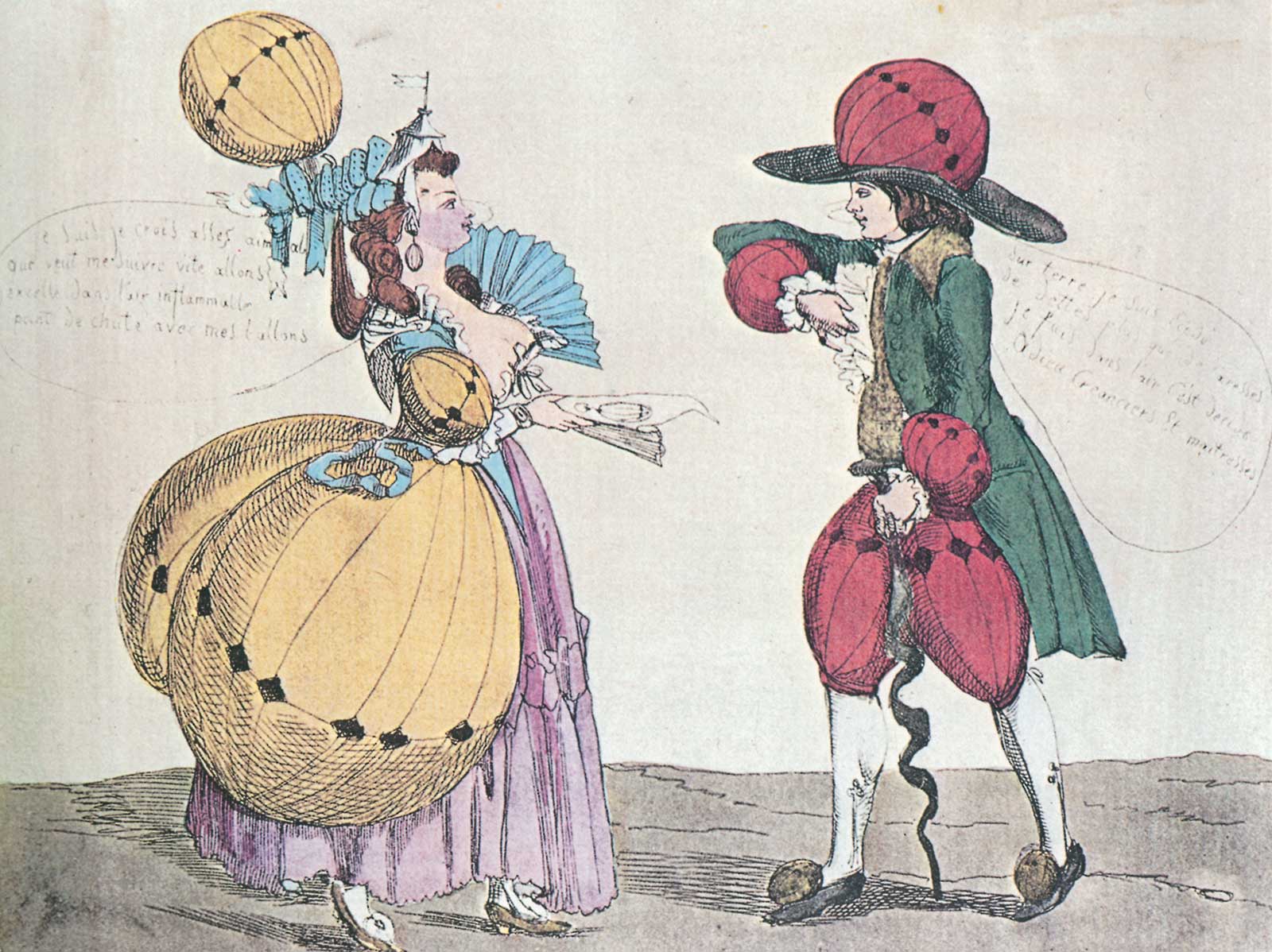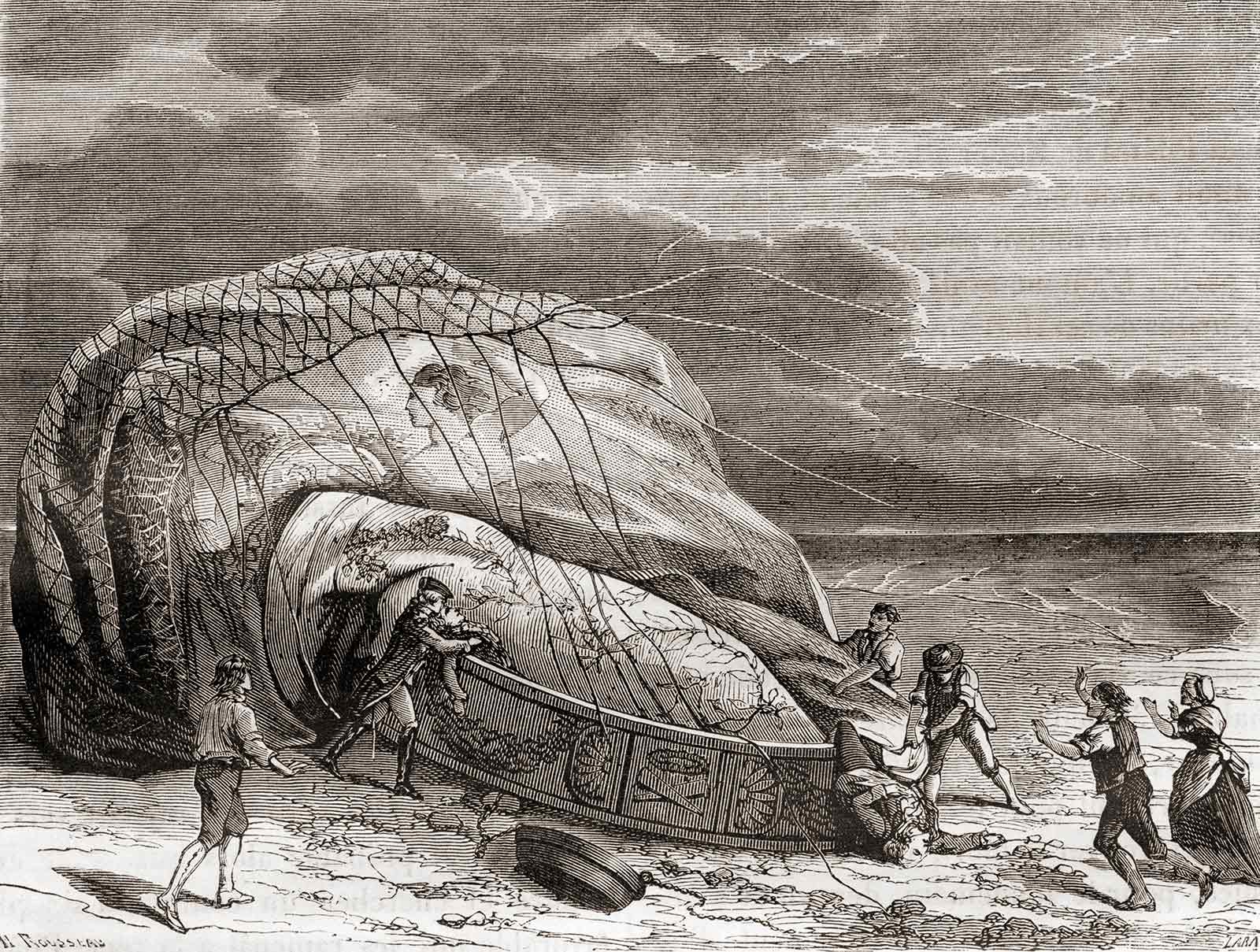The Interior’s Frontier
A voyage along the supply chain of my room
Boaz Levin

The last decades of the eighteenth century saw a rush to conquer new altitudes. In June 1783, the first successful hot-air balloon flight took place in Versailles, attended by the royal family and an audience of sixty thousand, as the brothers Joseph-Michel and Jacques-Étienne Montgolfier set afloat a balloon carrying a sheep, a cock, and a duck. A piloted flight quickly followed in October that year, with Jean-François Pilâtre de Rozier, a chemist, on board. The flight was a success, hailed by the press as “a spectacle, the like of which was never shewn since the world began.”[1] An audience of 100,000—including, once again, the royal family—marveled. A hot-air balloon boom ensued, spreading virally to England and Italy with the help of the newly popularized press, printed colored postcards, and the latest fashion—voluminous balloon-styled dresses and matching puffed bonnets, in what was described at the time as “balloonomania.”[2]
Several months later, in April 1784, two young friends would try to become the first to travel in a hot-air balloon over Savoy, then still part of the Kingdom of Piedmont-Sardinia. Keen to have a taste of the “aerostatic experience” and “travel through a region unknown to past generations,” twenty-year-old Xavier de Maistre and twenty-four-year-old Louis Brun, both serving in the Piedmontese army, mounted a large balloon that briefly floated several meters off the ground before crashing, its delicate taffeta canopy going up in flames.[3] Luckily, the two were left unscathed and, undeterred, they used fabric purchased from the Montgolfiers to construct a second balloon that was lighter and more robust. This time, they flew for twenty-five minutes and reached an altitude of 950 meters, guaranteeing—they must have thought—their place in history as the pilots of the eighth hot-air balloon to fly and land in one piece.[4]
But the enthusiasm was short-lived, as this apparent innovation quickly occasioned doubt and anxiety. Was this progress or just “hot air”? many of the commentators at the time were quick to pun. Was humanity flying to new heights and conquering frontiers? Or was it being pushed at whim by gusts of wind, or even worse, set aflame in front of mortified spectators and “dashed to pieces in a manner too shocking to mention,” as was indeed de Rozier’s gruesome fate.[5] His death in a widely reported crash while attempting to cross the English Channel, just two years after the Montgolfiers’ royal demonstration, is now often credited with the mania’s bust. It is this mix of anxiety and enthusiasm, hope and fear, boom and bust, that has led literary theorist Paul Keen to describe balloonomania, paraphrasing Laura Brown, as a kind of “fable of modernity,” emblematic of modern culture’s fate, caught as it is at the intersection of commerce and spectacle.[6]
• • •
Today, de Maistre is best remembered not for his brief aerostatic adventure—which is mentioned as an anecdotal aside, if at all—but rather for staying home. In 1790, following a duel with a Piedmontese officer, he was placed under house arrest for forty-two days, which prompted what turned out to be his most important adventure: a forty-two-day-long exploration, extensively documented in a text titled Voyage autour de ma chambre (Voyage Around My Room). The manuscript was published four years later—unbeknownst to Xavier—by his older brother, the counterrevolutionary political theorist Joseph de Maistre, who also supplied an introduction.[7] It quickly became a success.

The book’s publication came at the height of an age of exploration and colonization, with voyages such as those of James Cook, George Anson, and, later, Alexander von Humboldt taking place during the previous and following decades. Yet de Maistre’s adventure possessed “a particular merit that places it well above all preceding voyages,” wrote Joseph: unlike those voyages “traced on all the maps of the world with elegant dotted lines,” the sedentary adventure is one of its kind, taking place in a country that “no longer exists.” In no way an imaginary voyage, as Joseph was quick to warn, its “every page sparkles with realities.”[8]
And indeed, the Voyage is a mischievous and perplexing, if at times self-indulgent, sort of autofiction avant la lettre. From his lush pink-and-white bed—“two colors given to pleasure and happiness”—de Maistre sets sail for unknown literary territories: the fragment, stream of consciousness, digression, and what Beckett would eventually call “the within, all that inner space one never sees.”[9] He employs a range of typographic devices, such as asterisks and dashes, which not only highlight the text’s artifice but also lend the impression that the voyage is taking place simultaneously in his room, the caverns of his mind, and across the space of the page, a feature that Stephen Sartarelli, who translated the book into English, sees as a reference to Laurence Sterne’s Tristram Shandy.[10] Over the years, the Voyage became something of a cult classic, and its bed-bound protagonist’s soliloquies could be seen as precursors to works such as Ivan Goncharov’s Oblomov, Gertrude Stein’s Tender Buttons, Gaston Bachelard’s Poetics of Space, and Georges Perec’s Species of Spaces; Jorge Luis Borges pays explicit homage to it in his story “The Aleph,” in which the infinity of the universe is revealed through a point a “little more than an inch.”[11] And there are plenty of artworks, too, that seem to follow the path first plotted by the Voyage and its intimate mode of circumnavigation. Bruce Nauman’s Mapping the Studio videos come to mind, with their nocturnal infrared documentation of his empty studio filmed for one hour on each of forty-two nights—though they are perhaps more akin to de Maistre’s less successful sequel, Nocturnal Voyage Around my Room, which his brother dissuaded him from publishing during his lifetime based on “the Spanish proverb, Part II is always bad.”[12] Guy Ben-Ner’s brilliant restagings of Moby Dick and Robinson Crusoe in his compact apartment kitchen take things a step further; here, the perennial myths of the solitary castaway and shipwrecked sailor are displaced onto the markedly contemporary breed of stay-home dad in mortgaged asset. More recently, numerous works by Hans Schabus—including his 2010 sculptural dissection of a caravan titled after de Maistre’s book—stage a sort of parodic suburban reappearance of the artist-explorer, now stranded in the white cube.
Ostensibly, Voyage couldn’t be further away from the exoticizing travelogues of the author’s contemporaries and from his own youthful aerostatic experimentation: ironic, self-reflexive, and dealing with mundane minutiae, rather than the extremes of the colonial or scientific frontier. In Perec’s terms, it is an infra-ordinary work, or a form of topoanalysis, to quote Bachelard, “a systematic study of the sites of our intimate lives.”[13] But what if the interior and the frontier were simply two sides of the same coin? Could the Voyage have ever taken place without the hot-air balloon? And all those plundering travels to far-flung lands—what purpose would they serve without a space to fall back to, a cabinet to fill with curiosities, a collection to build, a shelter, a home, an interior?
For Walter Benjamin, the appearance of the interior coincides with the emergence of the private individual at the cusp of the modern age. These two phenomena were instrumental to the separation of public and private space and to the distinction between work and leisure. “Living means leaving traces,” he writes, and in the interior these traces are accentuated.[14] The interior became the private person’s universe, as well as his protective shell. It is there that the collector—the “true inhabitant of the interior”—could dream of redeeming objects from the “bondage of being useful.”[15] Similarly, Hannah Arendt wrote of a “modern enchantment with small things”, a petit bonheur that the modern subject could find “within the space of their own four walls, between chest and bed, table and chair, dog and cat and flowerpot, extending to these things a care and tenderness which, in a world where rapid industrialization constantly kills off the things of yesterday to produce today’s objects, may even appear to be the world’s last, purely humane corner.”[16] Both Benjamin and Arendt see the domestic interior as a space of respite, however fragile and momentary. But this space too would soon be transformed through mass production, consumption, and media; “indeed, almost as soon as it had been created,” writes historian Penny Sparke, “the modern domestic interior became an ‘object of desire,’ so widely represented that it rapidly became impossible to separate its idealized forms from its realized manifestations.”[17] Perhaps this explains the Voyage’s enduring success. The interior is fable as much as a real space, a vaporous image of itself—not unlike the hot-air balloon, its burner at full blast, the air around it quivering.
• • •
I’m writing this from my bed, à la Proust. The sheets are gray Ikea, not the luxuriant pink and white that de Maistre praises so, but they will have to do. Though I’ve been working mostly from home for several years now, since lockdown was announced in Berlin I’ve found myself easily distracted, worrying about relatives and friends in distant places, compulsively following various messaging groups, zooming in—or is it out?—to other similarly quarantined lives. Maybe in order to mark a difference from my normal mode of work, I’ve taken to writing from bed—pillow as ersatz desk—and, with the strange nature of these networked lockdowns in mind, to reading and rereading the various chroniclers of sedentary travel.
But what can we learn from the experience of such in-plorers in these times? It seems misleading to seek solace in the promise of confinement as if it were a welcome aberration from modernity and capitalism, a condition to be investigated in and of itself. Following such a logic has led some commentators to describe the lockdown measures as a sort of violent cure for the follies of our global economy—an insatiable appetite for growth, excessive travel, increasing inequality, and precarity all brought to a grinding halt by a virus that preys alike on rich and poor, north and south. Yet it’s already clear that its consequences, how deadly the virus will eventually turn out to be in different places, will be determined by years of policy—not only by crude resources, but by how these were distributed and put to work, and for whom.[18] And indeed, in much of our radically unequal world, even a home in which to confine oneself can’t be taken for granted, let alone the means to do so over an extended period of time.

Perhaps the lesson to be learned, then, concerns the relation between the balloon-boom and the voyage around the room, what one may call the dialectic of the interior and the frontier, both products of the same industrial modernity. What could be more symbolic of this relation than the fact that Amazon—a corporation whose name evokes the fantasy of distant frontiers conquered, and whose sole purpose is to convey the object of our every consumptive desire directly to our homes by logistical sleight of hand (read: cheap labor)—is one of the main economic beneficiaries of this predicament. In other words, the interior should be considered as dialectically bound with the exterior, as interdependent and mutually constitutive. How this can be done is beautifully demonstrated by Stealing Beauty, Guy Ben-Ner’s 2007 magnum opus, which he shot around the world in various Ikea stores, famous for their uniform design. In the work, the artist, his two children, and his then-wife act out a series of sitcom-like domestic sketches among unwitting shoppers at the stores, each scene ending when the family is discovered and asked to leave by the staff. In one scene, his daughter reads aloud from Friedrich Engels’s 1884 book The Origin of the Family, Private Property and the State. Interior and exterior are here turned inside out; not only is the family conditioned by notions of private property, but the domestic is the supply chain. The voyage around our room, Ben-Ner seems to suggest, should lead us to explore not just a Beckettian “within,” but the unequal reality of our networked global economy.
- Paul Keen, Literature, Commerce, and the Spectacle of Modernity, 1750–1800 (Cambridge: Cambridge University Press, 2012), pp. 44–45.
- Ibid., pp. 63–64.
- Xavier de Maistre, “Prospectus de l’expérience Aérostatique de Chambéry” (Chambéry, France: F. Puthod, 1784), p. 6. My translation. Available at <gallica.bnf.fr/ark:/12148/bpt6k1048528j/f13.image>.
- Jean-Jacques Tijet, Histoires choisies de Savoie (Paris: BoD - Books on Demand, 2016), p. 134.
- John T. Alexander, “Aeromania, ‘Fire-Balloons,’ and Catherine the Great’s Ban of 1784,” The Historian, vol. 58, no. 3 (Spring 1996), p. 513
- Paul Keen, Literature, Commerce, and the Spectacle of Modernity, p. 44.
- Richard Howard, “Introduction,” in Xavier de Maistre, Voyage Around My Room:Selected Works of Xavier de Maistre, trans. Stephen Sartarelli (New York: New Directions, 1994), p. vii.
- Joseph de Maistre, “Preface,” in Xavier de Maistre, Voyage Around My Room, pp. 187–188. Italics in original.
- Samuel Beckett, Molloy (New York: The Grove Press, 1955), p. 11.
- Stephen Sartarelli, “Notes and Variants,” in Xavier de Maistre, Voyage Around My Room, p. 194.
- Jorge Luis Borges, “The Aleph,” in The Aleph and Other Stories, 1933–1969, ed. and trans. Norman Thomas di Giovanni in collaboration with the author (New York: Dutton, 1970), p. 6.
- Richard Howard, “Introduction,” in Xavier de Maistre, Voyage Around My Room, p. viii.
- Georges Perec, “Approaches to What?”, in Species of Spaces and Other Pieces, trans. and ed. John Sturrock (New York: Penguin, 1997), p. 210. Gaston Bachelard, The Poetics of Space, trans. Maria Jolas (Boston: Beacon Press, 1994), p. 8.
- Walter Benjamin, “Paris — Capital of the Nineteenth Century,” New Left Review, no. 48 (March–April 1968), p. 84.
- Ibid.
- Hannah Arendt, The Human Condition (Chicago: University of Chicago Press, 1958), p. 52.
- Penny Sparke, The Modern Interior (London: Reaktion Books, 2008), p. 15.
- John Eligon, Audra D. S. Burch, Dionne Cearcey, and Richard A. Oppel Jr., “Black Americans Face Alarming Rates of Coronavirus Infection in Some States,” The New York Times, 7 April 2020. Available at nytimes.com/2020/04/07/us/coronavirus-race.html. See also: Benjamin Wallace-Wells, “Inequality Intensifies the Coronavirus Crisis in Detroit,” The New Yorker (online), 7 April 2020. Available at newyorker.com/news/news-desk/the-coronavirus-and-inequality-meet-in-detroit.
Boaz Levin is a Berlin-based writer, curator, and filmmaker, and an editor of Cabinet’s Kiosk platform. In 2017, he was co-curator of the Biennale für Aktuelle Fotografie, which is staged at exhibition venues in Heidelberg, Mannheim, and Ludwigshafen, and is co-curator of the 3rd Chennai Photo Biennale, taking place in Chennai, India, in December 2020.
If you’ve enjoyed the free articles that we offer on our site, please consider subscribing to our nonprofit magazine. You get twelve online issues and unlimited access to all our archives.